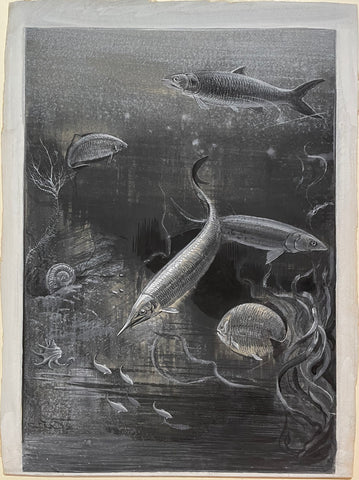
Charles Whymper (1853-1941), Fishes of the Jurassic Period
Charles Whymper (1853-1941)
Fishes of the Jurassic Period
Original Illustration in pen, ink and grey wash, heightened in white
c.1905-1912
Unsigned
12 x 9 in. sheet
Original artwork for Henry R. Knipe’s Nebula to Man. Illustrated on page 59. Species identified as, from upper left going clockwise: Hypsocormus, Caturus, Chondrostreus, Dapedius, Sprattiformis, Aspidorhynchus.
CHARLES WHYMPER (1853-1941)
Charles H. Whymper (31 August 1853 - 25 April 1941), aka C. Whymper, was a British painter and illustrator. He was born in London. His father, Josiah Wood Whymper (1813-1903), was a well-known painter and engraver. Whymper was educated at the Royal Academy Schools. He exhibited at the Royal Academy, Royal Society of British Artists, Royal Institute of Painters in Watercolors, the New Gallery, and the Fine Art Society, London. In 1909, Whymper was elected to the Royal Institute of Painters in Watercolors. Whymper was a prolific book illustrator specializing in travel, animal, and hunting themes. He also contributed to The Illustrated London News, Good Words, and The English Illustrated Magazine.
ORIGINAL WATERCOLORS PREPARED FOR HENRY KNIPE’S
NEBULA TO MAN (1905) & EVOLUTION IN THE PAST (1911-1912)
An exceedingly rare collection of original watercolors prepared for Henry Knipe’s Nebula to Man (1905) and Evolution in the Past (1911-1912) by naturalist-artists Alice Woodward, Josef Smit, and Charles Whymper.
Drawings prepared for Knipe’s Nebula to Man (1905) contributed to one of the most important publications on dinosaurs on the heels of the Great Dinosaur Rush or Bone Wars. The Bone Wars occurred between 1877 and 1892 between Edward Drinker Cope, the Academy of Natural Sciences Philadelphia, and Othniel Charles Marsh, the Peabody Museum of Natural History at Yale. These early paleontologists fought ruthlessly to pursue dinosaur fossils, a quest that resulted in an extraordinary period of discovery and the eventual financial ruin of both scientists. Their findings resulted in unearthing 136 new dinosaur species, ushering in a new paleontological research era.
According to Henry Knipe’s obituary, he worked for the British Museum. It was there that he likely met the artists tapped for this project. Knipe chose each illustrator for their reputation for scientific authenticity—namely, those skilled as bird artists, given the many similarities between bird species and dinosaurs.
We Also Recommend

![Albertus Seba (1665-1736) Tab I [Insects]](http://aradergalleries.com/cdn/shop/products/I_large.jpg?v=1635434052)
![Albertus Seba (1665-1736) Tab II [Insects]](http://aradergalleries.com/cdn/shop/products/II_large.jpg?v=1635434726)
![Albertus Seba (1665-1736) Tab III [Insects]](http://aradergalleries.com/cdn/shop/products/III_large.jpg?v=1635434877)
![Albertus Seba (1665-1736) Tab L [Insects]](http://aradergalleries.com/cdn/shop/products/L_b_large.jpg?v=1635435506)
![Albertus Seba (1665-1736) Tab L [Insects]](http://aradergalleries.com/cdn/shop/products/L_large.jpg?v=1635437893)